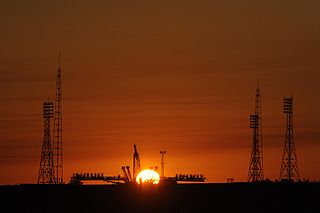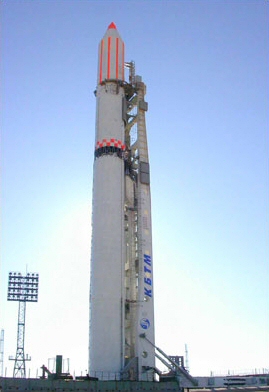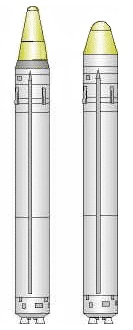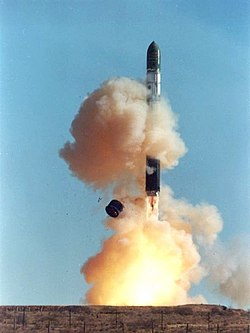
Soyuz is a family of expendable Russian and Soviet carrier rockets developed by OKB-1 and manufactured by Progress Rocket Space Centre in Samara, Russia. With over 1,900 flights since its debut in 1966, the Soyuz is the rocket with the most launches in the history of spaceflight.

The R-7 Semyorka, officially the GRAU index 8K71, was a Soviet missile developed during the Cold War, and the world's first intercontinental ballistic missile. The R-7 made 28 launches between 1957 and 1961, but was never deployed operationally. A derivative, the R-7A, was deployed from 1959 to 1968. To the West it was unknown until its launch. In modified form, it launched Sputnik 1, the first artificial satellite, into orbit, and became the basis for the R-7 family which includes Sputnik, Luna, Molniya, Vostok, and Voskhod space launchers, as well as later Soyuz variants.

The Baikonur Cosmodrome is a spaceport operated by Russia within Kazakhstan. Located in the Kazakh city of Baikonur, it is the world's first spaceport to be used for orbital and human launches. In terms of area, it is the largest operational space launch facility. All Russian crewed spaceflights are launched from Baikonur.

Plesetsk Cosmodrome is a Russian spaceport located in Mirny, Arkhangelsk Oblast, about 800 km north of Moscow and approximately 200 km south of Arkhangelsk, the cosmodrome dates to 1957. Originally developed as an ICBM site for the R-7 missile, it also served for numerous satellite launches using the R-7 and other rockets. Its high latitude makes it useful only for certain types of launches, especially the Molniya orbits, so for much of the site's history it functioned as a secondary location, with most orbital launches taking place from Baikonur, in the Kazakh SSR. With the end of the Soviet Union, Baikonur became a foreign territory, and Kazakhstan charged $115 million usage fees annually. Consequently, Plesetsk has seen considerably more activity since the 2000s.

Töretam is a station on the main Moscow to Tashkent railway, located in Kazakhstan. The name means "Töre's grave" in the Kazakh language. Töre, or more formally, Töre-Baba, was a noble and descendant of Genghis Khan. Töretam is near the Baikonur Cosmodrome, a Russian – formerly Soviet – spaceport, and near the city of Baikonur, which was constructed to service the cosmodrome.

Zenit is a family of space launch vehicles designed by the Yuzhnoye Design Bureau in Dnipro, Ukraine, which was then part of the Soviet Union. Zenit was originally built in the 1980s for two purposes: as a liquid rocket booster for the Energia rocket and, equipped with a second stage, as a stand-alone middle-weight launcher with a payload greater than the 7 tonnes of the Soyuz but smaller than the 20 tonnes payload of the Proton. The last rocket family developed in the USSR, the Zenit was intended as an eventual replacement for the dated Soyuz and Proton families, and it would employ propellants which were safer and less toxic than the Proton's nitrogen tetroxide/UDMH mix. Zenit was planned to take over crewed spaceship launches from Soyuz, but these plans were abandoned after the dissolution of the Soviet Union in 1991.
The Tsyklon, GRAU index 11K67, was a Soviet-designed expendable launch system, primarily used to put Cosmos satellites into low Earth orbit. It is based on the R-36 intercontinental ballistic missile designed by Mikhail Yangel and made eight launches, with seven successes and one failure. All of its launches were conducted from LC-90 at the Baikonur Cosmodrome. It is sometimes designated Tsyklon-2A, not to be confused with the later Tsyklon-2 rocket. It was introduced in 1967 and was derived from the R-36 ICBM. It was retired in 1969.

The Dnepr rocket was a space launch vehicle named after the Dnieper River. It was a converted ICBM used for launching artificial satellites into orbit, operated by launch service provider ISC Kosmotras. The first launch, on April 21, 1999, successfully placed UoSAT-12, a 350 kg demonstration mini-satellite, into a 650 km circular Low Earth orbit.

The State Space Agency of Ukraine is the Ukrainian government agency responsible for space policy and programs. Along with the Ukrainian Defense Industry and the Antonov Aeronautical Scientific-Technical Complex, it is a major state complex of the national defense industry of Ukraine.The agency was formed in 1992 based on the Soviet space program infrastructure remaining in Ukraine following the dissolution of the Soviet Union.

Rokot, also transliterated Rockot, was a Soviet Union space launch vehicle that was capable of launching a payload of 1,950 kilograms (4,300 lb) into a 200-kilometre (120 mi) Earth orbit with 63° inclination. It was based on the UR-100N intercontinental ballistic missile (ICBM), supplied and operated by Khrunichev State Research and Production Space Center. The first launches started in the 1990s from Baikonur Cosmodrome out of a silo. Later commercial launches commenced from Plesetsk Cosmodrome using a launch ramp specially rebuilt from one for the Kosmos-3M launch vehicle. The cost of the launcher itself was about US$15 million in 1999; The contract with European Space Agency (ESA) for launching Swarm in September 2013 was worth €27.1 million.
SumbandilaSat, was a South African micro Earth observation satellite, launched on 17 September 2009 on a Soyuz-2 launch vehicle from the Baikonur Cosmodrome. The first part of the name, Sumbandila, is from the Venda language and means "lead the way".

Dombarovsky is a military airbase 5 kilometres (3.1 mi) northwest of the village of Dombarovsky, near Yasny in Russia's Orenburg Oblast. Operated by the Soviet Air Forces and later by the Russian Air Force, it hosted fighter interceptor squadrons and hosts an ICBM base with a supporting helicopter base.

Gagarin's Start, also known as Baikonur Site 1 or Site 1/5 is a launch site at Baikonur Cosmodrome in Kazakhstan that was used for the Soviet space program and is now managed by Roscosmos.

Strela is a Russian orbital carrier rocket, derived from the Soviet/Russian UR-100NU missile. It conducted its maiden test launch on 5 December 2003, carried its first functional payload on 27 June 2013, and a second one on 19 December 2014.
A number of suborbital spaceflights were conducted during 2008. These consist mostly of sounding rocket missions and missile tests, and include other flights such as an ASAT firing. Between the start of the year and 16 July, at least 43 publicly announced suborbital spaceflights were conducted, the first of them on 11 January.

Site 45 at the Baikonur Cosmodrome used to be a Zenit rocket launch site consisting of two pads, both of which are currently inactive. It used to be the launch site for all Soviet and Russian government Zenit launches, along with a commercial launch conducted for Globalstar in 1998, and continuing commercial launches under the Land Launch programme. The main pad at the site is area 45/1, which was completed in 1983 following five years of construction. A second pad, area 45/2, was completed in 1990, but was destroyed by a launch failure in the same year.

The Kosmos-3 was a Soviet carrier rocket, derived from the R-14 missile, which was used to orbit satellites between 1966 and 1968. It was quickly replaced by the modernised Kosmos-3M. Six were flown, four as orbital carrier rockets, and two on sub-orbital flights. All launches occurred from Site 41/15 at the Baikonur Cosmodrome.
UK-DMC 2 is a British Earth imaging satellite which is operated by DMC International Imaging. It was constructed by Surrey Satellite Technology, based on the SSTL-100 satellite bus. It is part of Britain's contribution to the Disaster Monitoring Constellation, which is coordinated by DMC International Imaging. It is the successor to the UK-DMC satellite.

Site 41 was a complex of three launch pads at the Baikonur Cosmodrome originally built for flight testing of Intercontinental ballistic missile (ICBMs) using storable propellant. The need to develop such missiles was determined by low-tactical-technical and operational characteristics of the first Soviet ICBM R-7 created by the OKB-1 under the guidance of Sergei Pavlovich Korolev. May 13, 1959 by a special decree of the Central Committee of the CPSU and the CM of the design Bureau «Yuzhnoye» assigned to develop an Intercontinental ballistic missile on storable components of propellant, which has received designation R-16 and index – 8К64. Together with 41 platform built platform No. 42 – technical and No. 43 – for residing of serving military personnel and representatives of the industry.
















